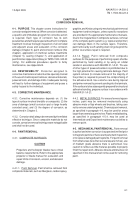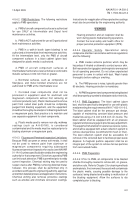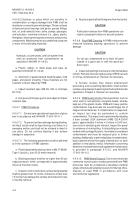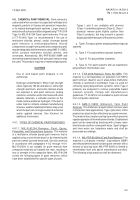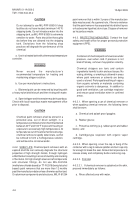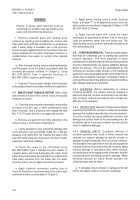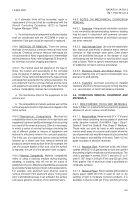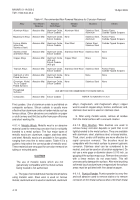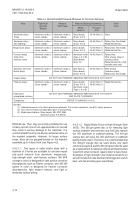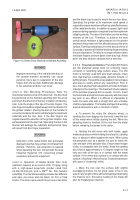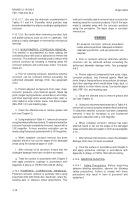TM-1-1500-344-23-2 - Page 85 of 240
4-9
NAVAIR 01-1A-509-2
TM 1-1500-344-23-2
15 April 2009
b. If allowable limits will be exceeded, repair or
replacement of the part shall be coordinated with the
Aircraft Controlling Custodians (ACC) or System
Program Manager (SPM).
c. If a critical structural component is affected, repairs
shall be coordinated with the ACC/SPM in order to
determine if the part should be repaired or replaced.
4-8.4. METHODS OF REMOVAL. There are various
methods of mechanical corrosion removal from metal
surfaces. Chemical corrosion removal techniques are
not authorized for Navy organizational or intermediate
level maintenance. Army: refer to Appendix B, Section III,
for chemical corrosion stripping procedures.
4-8.4.1. The method used will depend on the type of
metal, the location and accessibility of the corroded
area, the degree of damage, and the type of corrosion
involved. These factors will determine the types of tools
and equipment selected for the removal operation. It is
very important that the removal method and the tools
and equipment selected be compatible with the metal
surface. Compatibility involves two considerations:
a. The mechanical effect of the equipment on the
surface and
b. The compatibility of metallic particles worn off the
removal equipment which might become trapped in the
metal surface.
4-8.4.2.Mechanical Compatibility. Mechanical
compatibility refers to the selection of the right tools and
equipment to prevent additional damage from occurring
as a result of the removal process. Often it is necessary
to select a series of removal techniques involving the
use of different grades or classes of equipment and
material to effectively remove the corrosion products.
The initial use of a rapid and coarse removal method
followed by a slower and finer removal method will
produce a smooth metal surface finish (for example, the
use of a vacuum blaster at first, and, once the surface
is exposed, the use of a fine abrasive cloth or paper).
4-8.4.3. Material Compatibility. Material compatibility
refers to using a cleaning medium during brushing,
abrading, or blasting, that will not be the cause of
additional corrosion. Material compatibilities are assured
by using like metals during corrosion removal operations.
For example, only aluminum wool shall be used to
remove corrosion from aluminum alloys. Using steel
wool is prohibited because it can embed in the surface
and cause galvanic corrosion of the aluminum alloy.
4-8.5. NOTES ON MECHANICAL CORROSION
REMOVAL.
4-8.5.1. Aluminum. Intergranular exfoliation corrosion
is not removed by abrasive blasting; however, blasting
may be used in conjunction with powered corrosion
removal to determine whether all exfoliation corrosion
has been removed.
4-8.5.2. High Strength Steel. Use only the radial bristle
disc, flap brush and wheel, or abrasive mat to remove
corrosion on high strength steel parts. Other power
tools are prohibited because of the danger of local
overheating and the formation of notches which could
lead to failure. Refer to specific maintenance manuals
for additional corrosion removal procedures.
4-8.5.3. Stainless Steels and Nickel Alloys. Use
abrasive blasting only on heavily corroded parts as a
precursor to acid pickling.
4-8.5.4. Fasteners. Corrosion occurring on installed
fasteners shall be removed using dry honing machine
(i.e., vacu-blaster) or hand held abrasive materials
4-9. CORROSION REMOVAL EQUIPMENT AND
MATERIALS.
4-9.1. NON-POWERED TOOLS AND MATERIALS.
Refer to Table 4-1 to determine the correct non-powered
abrasive to use on various aircraft metals.
4-9.1.1. Abrasive Mats. Abrasive mats (9" x 11" sheets)
are nylon webs containing various grades of aluminum
oxide abrasive material (A-A-58054 Type I Class 1
Grade A - Very Fine, Grade B - Fine, Grade C - Medium).
These mats are used by hand or with mandrels to
remove small areas of corrosion and/or paint where the
use of powered tools would be impractical or prevented
by the shape or accessibility of the area. Table 4-2 is a
guide to grades of abrasive materials.
4-9.1.2. Abrasive Cloth. Aluminum oxide and silicon
carbide (ANSI B74.18) grit bonded to cloth are used for
dry sanding of light to moderate corrosion products. The
cloth is available in sheets (9"X11") and rolls (2" or 3"
wide X 150" long) in 240 grit (Fine) and 320 grit (Very
Fine) grades. Use of aluminum oxide is prohibited on
composite surfaces.
4-9.1.3. Abrasive Paper. Silicon carbide grit bonded to
heavy paper (ANSI B74.18) is used for wet or dry
sanding of light to moderate corrosion products. It is
available in sheets in 240 grit (Fine) and 320 grit (Very
Back to Top



